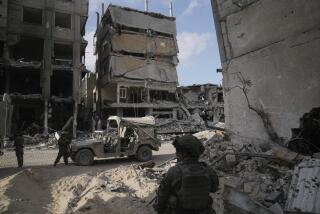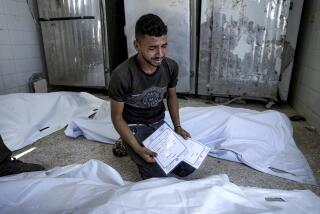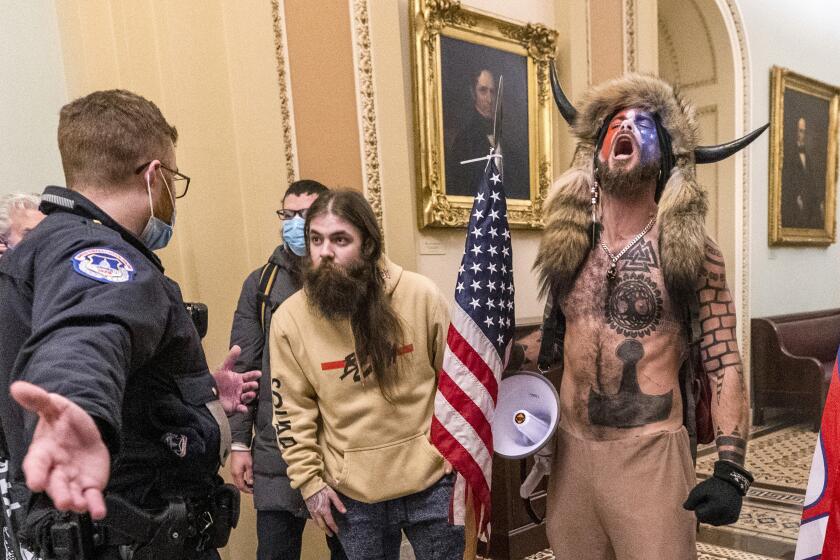U.S. drone attacks in Pakistan get mixed response
Reporting from Kundian, Pakistan, and Bagram, --
Their whir is unmistakable, a buzzing hum that prompts the tribespeople of Waziristan to refer to the fleet of armed U.S. drone aircraft hovering overhead as machay, or wasps.
The Khan family never heard it. They had been sleeping for an hour when a Hellfire missile pierced their mud hut on an August night in 2008. Black smoke and dust choked villagers as they dug through the rubble.
Four-year-old Zeerak’s legs were severed. His sister Maria, 3, was badly scorched. Both were dead. When their cousin Irfan, 16, saw them, he gently curled them into his arms, squeezed the rumpled bodies to his chest, lightly kissed their faces, and slid into a stupor.
Drones have transformed combat against Islamic militants in Pakistan’s tribal areas, the rugged belt of villages and badlands hugging the border with Afghanistan. Since 2004, analysts say, Predator and Reaper drones operated by the CIA have killed at least 15 senior Al Qaeda commanders, as well as several top Pakistani Taliban leaders and hundreds of fighters.
The small unmanned planes can hover for hours while gathering infrared camera footage. Onboard lasers pinpoint targets for supersonic Hellfire missiles or 500-pound bombs. The attacks cost no American lives.
But civilians who had nothing to do with the Taliban or Al Qaeda also die in these strikes. Calculations of how many vary widely, from fewer than 30 since 2008 to more than 700 just last year. The Pakistani government restricts access to the tribal areas and has only nominal control there. Militants seal off attack sites, and victims are buried quickly, according to Islamic tradition.
Still, the deaths inflame anti-American suspicions, particularly among middle- and upper-class Pakistanis outside the tribal areas, many of whom are convinced that Washington wants to colonize their country or wrest control of its nuclear arsenal.
Inside the poor, isolated and politically powerless tribal areas, the reaction is more nuanced. Some say bluntly that they would avenge the killing of their relatives, if they could only reach those remotely piloting the drones buzzing thousands of feet over their heads. Others say they understand the need for the program, and even support it if it helps drive out the militants. They loathe the constraints the Taliban places on everyday life.
But many don’t understand why a technology that pinpoints its targets with lasers and infrared cameras can also kill innocents. And they would prefer that Pakistanis, rather than Americans, were flying the drones.
The CIA’s covert Predator and Reaper drone missions over Pakistan are separate from the U.S. military’s unmanned flights in Afghanistan and Iraq, U.S. military officials say.
Pakistanis are in some ways partners in the effort. U.S. conventional forces are banned from the tribal areas, but Pakistan tacitly acquiesces to Washington’s reliance on drones to strike militant camps and hide-outs. The U.S. also relies heavily on the Pakistani military and intelligence services for on-the-ground information. If the intelligence is faulty, or if civilians are near militant targets, civilian casualties are almost inevitable.
“We’ve become sort of the counterinsurgency air force of Pakistan,’’ said Micah Zenko, a national security scholar at the Council on Foreign Relations.
U.S. officials say the strikes have weakened the leadership of Al Qaeda and the Pakistani Taliban and disrupted their operations, while minimizing civilian casualties.
“We believe the number of noncombatant casualties is under 30, those being people who were near terrorist targets, while the total for militants taken off the battlefield exceeds 500,” said a U.S. counter-terrorism official who spoke on condition of anonymity.
The official said the estimate was based on various types of intelligence, as well as observations made before and after the strikes, and characterized unofficial estimates as little more than guesses.
“Targets are chosen with extreme care, factoring in concepts like necessity, proportionality and an ironclad obligation to minimize loss of innocent life and property damage,” the official said.
Militants have an incentive to spread stories of atrocities resulting from the drone operations but have been unable to provide any detail to back up such propaganda claims, the official added.
In August 2009, a drone strike killed Baitullah Mahsud, the Pakistani Taliban chief responsible for the assassination of former Prime Minister Benazir Bhutto. However, according to an analysis by the New America Foundation, a Washington think tank, drone attacks had missed him at least 16 times in the preceding 14 months. An estimated 280 to 410 people died in those attacks, it said. About 150 to 175 were believed to be militants. The rest were listed as “other,” many of them civilians.
Pakistani news reports have quoted authorities as saying that 708 civilians were killed in U.S. drone strikes in 2009 alone. The Long War Journal, a website that uses news reports and contacts with security sources in Afghanistan and Pakistan to track drone strikes, puts the number at 43, and a cumulative 94 since 2006. It estimated that more than 1,100 militants were killed last year in such aerial attacks.
People whose families suffered casualties were interviewed outside the tribal areas. In each case, local or national Pakistani authorities, speaking on condition of anonymity, verified that a drone strike had taken place. Many of those interviewed said they simply didn’t understand why their relatives were hit.
Shakir Khan, 22, a wiry grocer with a patchy black beard and piercing brown eyes, said Taliban militants freely roamed the dirt lanes of his village, Gangi Khel, in summer 2008 when the missile hit his home. They strode through town like self-appointed marshals, bandoleers slung across their shalwar kameez tunics, long black hair flowing out from their Pashtun caps.
But no one in Khan’s family has any ties to the Taliban, he said in an interview in Kundian, about 80 miles from the Waziristan border, and militants never visited his house. All the same, his nephew Zeerak and niece Maria were killed. Irfan, another nephew, has been mired in a deep depression.
Five of their 12 rooms are still sufficiently intact for Khan, his three brothers and their families to live there. Shakir is angry that the family has suffered despite keeping a distance from the militants.
“If Americans think that everyone who prays five times a day is a militant, they’re wrong,” Khan said. “They kill us without any reason. If they know about Taliban or Al Qaeda, OK, be specific and attack and kill them. But don’t kill innocent people.”
Drone strikes are not the only risk in the tribal areas. Al Qaeda and the Taliban have responded to the aerial assaults by stepping up assassinations of residents accused of providing targeting information to Pakistani or U.S. intelligence agencies, researchers say. Attacks and assassinations by militants, and air and artillery strikes by the Pakistani military, actually kill far more civilians there than the drones, Pakistani researchers say.
Khadim Hussain, coordinator at the Aryana Institute for Regional Research and Advocacy, an independent think tank in Islamabad, the Pakistani capital, that studies issues affecting the tribal areas, said residents of the tribal areas objected to the militants’ influence on their lives.
“Many of them told us they would like these bastards to be killed, but would like the Pakistani state to do it,’’ Hussain said. “They say they’re unable to dance their traditional dances, or assemble without the permission of the local militant commander. These things trespass on their honor code, their lifestyle and their culture.”
In a poll of 550 tribal area residents by the institute last year, 58% said drone attacks did not foster anti-American sentiment. Fifty-two percent said the strikes were accurate, and 60% said they damaged insurgent groups. Farhat Taj, an anthropologist who grew up in the area, said residents of some tribal areas aren’t concerned about drones violating Pakistani sovereignty because Pakistan doesn’t exercise control there, anyway.
In some tribal areas that have not been targeted, such as the Malakand district of the North-West Frontier Province, residents have requested drone attacks against local militants, said Samina Ahmed, project director for the International Crisis Group in Islamabad.
Some analysts say that not all civilians are equally mourned. The strike that killed Taliban leader Mahsud, for instance, also killed his wife and her parents. Family members perceived as helping militants are not much mourned, particularly if they are Arabs or other outsiders, some researchers say.
“It sounds callous to say, but it’s not the same as when innocent local bystanders are killed,” said Bill Roggio, founder of the Long War Journal.
In some villages, though, Taliban militants are native sons.
Many of the boys that Zaman Khan grew up with in the South Waziristan town of Shakai eventually joined the Taliban. He knew they had become militants, but he never thought it odd to have them over for tea.
Whether it was because of Taliban visits or the proximity of a regular Taliban meeting place 30 yards away, Khan’s house became a target March 15, 2008.
The missile struck while everyone slept, killing Khan’s brother, Wazir Khan, 40; Wazir’s wife, Zara Bibi, 30; and their 4-year-old son, Irshad. The left half of Wazir’s body had been sheared off. Zara’s and Irshad’s bodies were charred from head to toe.
Wazir’s two other children, Noor Rehman, 10 at the time, and Ishaq Khan, 3, survived. Physically, they recovered but suffer from psychological problems, Zaman Khan said.
“Ishaq doesn’t talk at all,” Khan said. “He can’t recognize his family, and he drinks only if someone helps him.”
Three weeks after that strike, a house full of civilians in the same neighborhood was struck, instantly killing cousins Sher Maan, 20, and Azeem Ullah, 30, and Azeem’s wife, Gul Anama, 25.
“It was a huge blast that shook the ground,” said Amin Ullah, 20, a Shakai farmer.
“I believe that most of the victims of these drone attacks are innocent people,” Ullah said. “Pakistan should be carrying out these attacks. Pakistan knows the terrain, knows its people and knows the militants.”
Andrew Exum, a former Army officer in Afghanistan and Iraq, has declared the drone program counterproductive and called for an end to it. In an analysis published last year, Exum and David Kilcullen, a former counterinsurgency advisor to the head of U.S. Central Command, Army Gen. David H. Petraeus, dismissed drones as technology substituting for strategy.
“Every one of these dead noncombatants represents an alienated family, a new desire for revenge, and more recruits for a militant movement,’’ they wrote.
Drones have proved invaluable in Afghanistan, where they focus on surveillance, intelligence-gathering and watching over coalition troops, Exum said in an interview. But in Pakistan, the U.S. and the government in Islamabad need to make the case that the attacks are part of a joint strategy supporting Pakistani policy, he said.
“I’m not saying drones can’t be part of the solution, but right now I think they’re part of the problem,’’ Exum said.
Drone attacks have enraged men such as Momin Khan. On a September morning last year, Khan heard the thunderclap of a drone strike in Machis, his village in North Waziristan, and ran to see what had happened.
As he joined other villagers running down a dirt road, the 50-year-old unemployed teacher saw black smoke and flames curling out of a house about 60 yards away. The missile had killed two people there. As he ran closer, a second missile strike shook the ground.
Shrapnel from the blast cut into his shoulder and legs. He woke up in a hospital.
Four people were killed in the second strike, he said. Although Taliban militants have often used Machis as a haven, Khan said he was sure the house initially targeted had only civilians in it.
“These drones fly day and night, and we don’t know where to hide because we don’t know who they will target,” he said. “If I could, I would take revenge on America.”
Philip Alston, the United Nations special representative on extrajudicial, summary or arbitrary killings, said that without full disclosure of the CIA drone program, “the opportunities for abuse are immense.”
“The CIA is running a program that is killing a significant number of people, and there is absolutely no accountability in terms of the relevant international law,’’ he said.
U.S. officials counter that the program is both legal and effective.
“U.S. targeting practices, including lethal operations conducted with the use of unmanned aerial vehicles, comply with all applicable law, including the laws of war,” State Department legal advisor Harold Koh said in a speech in March.
Rep. Loretta Sanchez (D-Garden Grove), chairwoman of the terrorism, unconventional threats and capabilities subcommittee of the House Armed Services Committee, said she is “in the comfort zone, considering who we’ve been able to take out” in drone strikes.
“We have a mandate to eliminate these people who are trying to hurt us,” Sanchez said. Even if political conditions allowed for U.S. ground troops in Pakistan, she said, that would almost certainly increase both civilian and U.S. military casualties.
Continued use of drone strikes, however, risks losing people like Dil Faraz Khan, a tribal elder in his 40s who despised the Taliban.
Faraz Khan assembled meetings of tribal leaders to brainstorm ways to resist the militants.
Survivors say Faraz Khan, three of his sons and a farmer were sitting in the family compound’s guest house one evening in February 2009 when a missile hit it.
Drones had been flying overhead all day. But Faraz Khan’s brother, Bara Khan, said the family felt safe because they were not Taliban.
The strike tore the family apart. Faraz Khan and two adult sons who helped support the household are dead, as is a 14-year-old son who was going to school in hope of freeing himself from stifling poverty.
And yet, Bara Khan says he understands the need for drone strikes. He said he’s convinced the attack was an aberration.
“Our thing happened because of a mistake,” said Khan, a silver-bearded Pashtun, who like his brother is a tribal elder. “I know that the Taliban and Al Qaeda are very much in trouble because of these attacks. These drone attacks really strike fear in them.”
David S. Cloud in the Washington bureau contributed to this report.
One in a series of occasional articles about America’s remote-controlled warfare.
More to Read
Sign up for Essential California
The most important California stories and recommendations in your inbox every morning.
You may occasionally receive promotional content from the Los Angeles Times.











